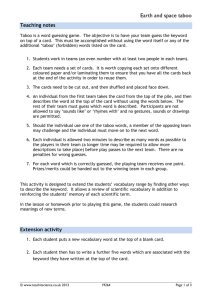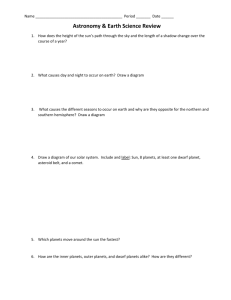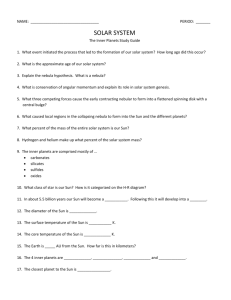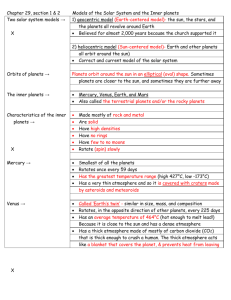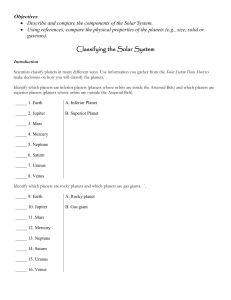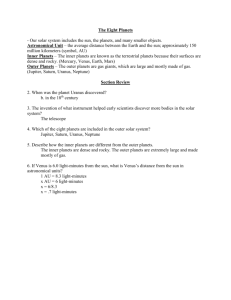The Planets
advertisement
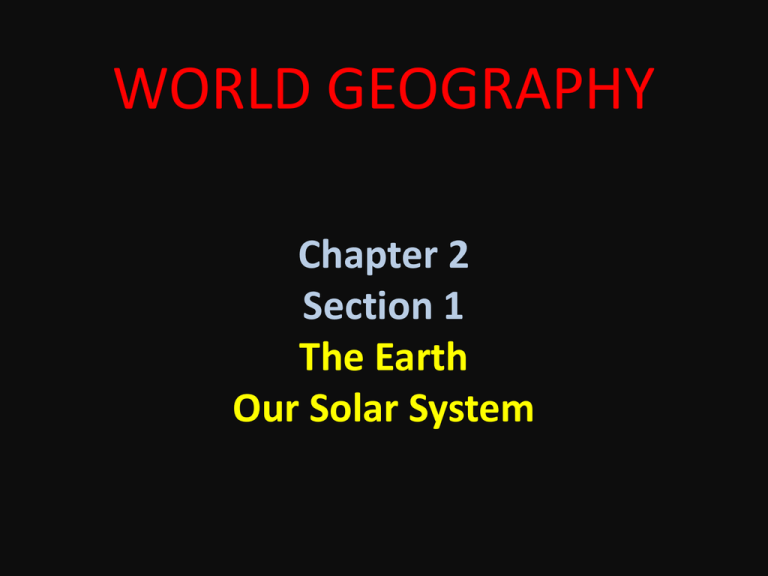
WORLD GEOGRAPHY Chapter 2 Section 1 The Earth Our Solar System Our Solar System • The Sun, a star, is the center of our solar system. • It is about 109 times bigger than our Earth. • 93 million miles from Earth. OUR OWN STAR!! The Planets: Neighbors in Space • Eight planets exist in our solar system. • Except for Mercury and Venus, all have satellites called moons. Pluto is no longer conside red a planet. Terrestrial Planets • • • • • Mercury, Venus, Earth, and Mars. All have solid rocky crusts. Mercury and Venus are scalding hot. Mars is a cold barren desert. Only Earth has liquid water on the surface and can support varieties of life. Terrestrial Planets Frank and Ernest on Planets Gas Giant Planets • Jupiter, Saturn, Uranus, and Neptune. • More gaseous, less dense, and larger than the terrestrial planets. • Each is like a miniature solar systems, with orbiting moons and thin, encircling rings. • Saturn’s rings can be easily seen from Earth. Gas Giant Planets SATURN RINGS CAN BE SEEN FROM PLANET EARTH Asteroids • Small, irregularly shaped, planet-like objects. • Mainly found between the orbits of Mars and Jupiter in a region called the asteroid belt. • A few asteroids follow paths that cross the earth’s orbit. Asteroid Belt COMETS • Made of icy dust particles and frozen gases. • Look like bright balls with long, feathery tails. • Orbits are inclined at every possible angle to the earth’s orbit. HALLEY’S COMET Halley’s Comet • The comet was named in honor of Edmond Halley, who predicted its appearance in 1758. • The average period of Halley‘s orbit is 76 years. • Its most famous appearance was in 1066 when it was seen at the Battle of Hastings. • Its next passage will be in 2062. METEOROIDS • Chunks of rock and iron. • Atmospheric friction usually burns them up before they reach the earth’s surface. • Called Meteorites when they collide with the earth. • A giant meteorite about 65 million years ago may have caused the end of the dinosaurs. EARTH • • • • Not a perfect sphere. The diameter at the Equator is about 7,930 miles. Has a circumference of about 24,900 miles. OUR MARBLE BLUE Hydrosphere The watery areas of the earth, including oceans, lakes, rivers, and other bodies of water. 70% of the earth’s surface. Lithosphere Lithosphere Surface land areas of the earth’s crust, including continents and ocean basins. 30% of the earth’s surface ATMOSPHERE • A layer of gases that surrounds the earth. • Extends about 6000 miles above the surface. • 78% nitrogen, 21% oxygen, small amounts of argon and other gases. Biosphere The part of the earth where life exists. Major Landforms • • • • • • • • Mountains Hills Plateaus Plains Others include valleys, canyons, and basins. Landforms contain rivers, lakes, and streams. Seven Continents • • • • • • • Africa Asia Antarctica (no Arctic Continent) Australia Europe North America South America Continental Shelf The part of a continent that extends underwater. Can slope out from land as much as 800 miles and descend to a depth of 600 feet. Palm Island in Dubai, UAE Mt. Everest The highest point on Earth at 29,035 feet above sea level Mariana Trench is the deepest place on earth at 35,827 feet below sea level. The Dead Sea is the lowest place on land at 1,349 feet below sea level. Death Valley is the lowest place in the United States


